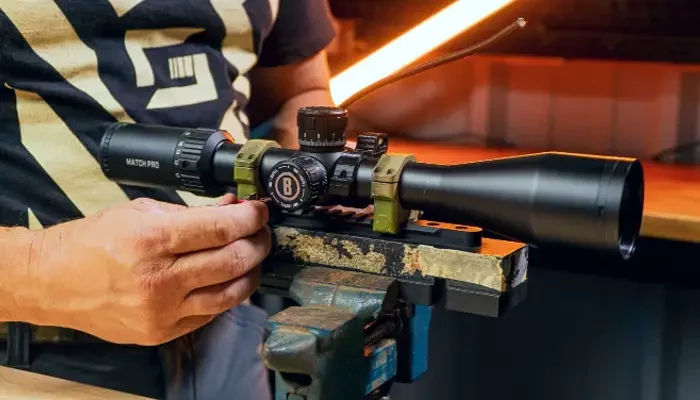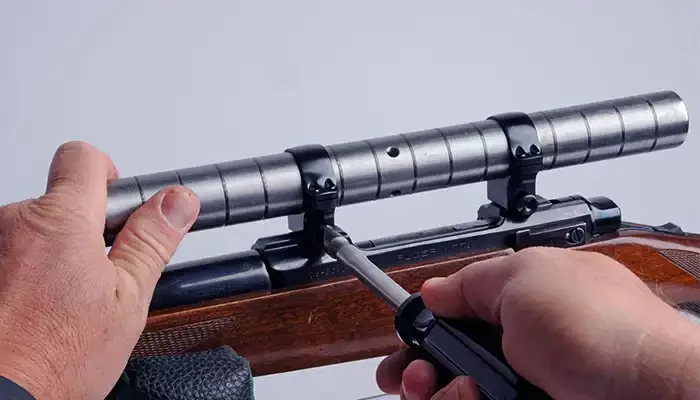Hey, you want an accurate target with your firearms, or if you are upgrading your firearm for the best performance.
Then you need a threaded barrel. A threaded barrel is a specific kind of gun barrel that has to thread on the end designed for the attachment of various kinds of muzzle devices, including compensators, suppressors, and flash hiders. You need a threaded barrel for the best setup of these muzzle devices.
Additionally, a threaded barrel is a specific type of barrel that gives shooters the option to equip their firearm with a variety of attachments, improving its functionality and flexibility for a variety of shooting situations.
What Is A Threaded Barrel?
The threaded barrel is the most important piece of equipment for various firearms. The threading on the barrel piece of equipment is too specific to ensure a tight and secure fit for the muzzle device.
This allows for easy attachment and detachment of the device as needed, making the firearm more versatile and adaptable to different shooting situations.
The threaded barrel is the most significant piece of gun equipment. The threading on the barrel is too precise to ensure a tight and secure fit for the muzzle device.
This equipment gives the ability for quick attachment and detachment of the firearms as needed, making the firearm more versatile and adaptable for various firing conditions.
Which Types Of Guns Use Threaded Barrels?
Threaded barrels are used with a variety of firearms, including pistols, rifles, and shotguns. Pistols, particularly those employed for tactical or competitive purposes, are one of the most frequent types of guns that have threaded barrels.
Many tactical and competition pistols have threaded barrels to facilitate the attachment of muzzle devices such as suppressors, compensators, or flash hiders.
- Pistols: Many tactical and competition pistols have threaded barrels that allow the attachment of muzzle devices such as suppressors, compensators, or flash hiders.
- Rifles: Threaded barrels of rifles used for hunting, tactical objectives, or long-range shooting enable the addition of muzzle devices such as suppressors, muzzle brakes, or flash hiders.
- Shotguns: Shotguns include threaded barrels that can be used to install choke tubes, allowing the shooter to adjust the pattern of the shot for different types of hunting or shooting circumstances.
- Submachine guns and machine guns: Threaded barrels are commonly used to attach suppressors or other muzzle devices that help to reduce noise and increase accuracy.
- Bolt-action rifles: Some bolt-action rifles, particularly those wanted for long-range shooting, have threaded barrels that allow suppressors or other muzzle devices to be attached.
Threaded barrels are especially popular in rifles built for tactical or competition use, as well as those used for hunting or long-range shooting.
However, not all rifles are designed to be used with threaded barrels, so it is critical to conduct research and select a firearm that is compatible with the muzzle device you plan on using.
How Many Types Of Threaded Barrels?
There are many types of threaded barrels available for firearms, and they can vary in terms of thread pitch, thread diameter, and thread direction. There are several types of threaded barrels for firearms.
It depends on thread pitch, thread diameter, and thread direction. And also depends on which types of calibers a shooter uses. Now we look out for various calibers in which a shooter uses different threaded barrels.
In What Calibers Do We Use Threaded Barrels?
Many types of calibers use different shorts of threaded barrels. Firstly, we explain the thread patterns.
- M means Metric (M13.5X1 means these numbers are metric instead of standard)
- LH stands for Left Hand. (M13.5X1 LH means the thread pattern is backward and threads in the opposite direction)
- RH stands for Right Hand. (M16X1 RH means the thread pattern should be the same as usually expected)
- TPI stands for Threads Per Inch.
Now we can see which types of calibers we use in different threaded barrels :
(1) .22LR, .22MAG, .17HMR – For these calibers, the commonly used thread is 1/2×28 .
(2) 9mm – The most common thread for 9mm firearms is 1/2×28, with the following exceptions:
- H&K: M13.5×1 LH
- M13.51 LH Sig Sauer (MPX)
- M13.51 LH Factory Glock H&K MP5-N: 1/2-30
(3) 40 S&W – With the exclusions that follow, 9/16×24 is the most common thread for .40 S&W firearms.
- H&K: M14.5×1 LH
- Sig Sauer M13.51 LH
- M14.51 LH Glock
(4) .45 ACP – Except for the following exceptions .578×28 is the most prevalent thread for .45 ACP weapons:
- H&K: M14.5×1 LH
- H&K USP Tactical: M16x1 LH
- H&K Mark 23 (Socom): M16x1 RH
- Glock: M16x1 LH
- KRISS Vector SMG: M16x1 LH
- Sig Sauer P220: .578”-28
(5) .308/7.62mm – For these types of calibers, the most significant tread pattern is 5/8×24. There are, however, several exceptions:
- SakoTRG: M18x1
- Accuracy International: M18x1.5
- AK-47: M14x1 LH
- FN SCAR 17: 5/8×24
- Springfield M1A SOCOM 16: .595×32
(6) .338 Lapua Magnum – 5/8×24 is the most common thread pattern. However, there are some exceptions:
- SakoTRG: M18x1
- Accuracy International: M18x1.5
- Desert Tactical Arms: 3/4×24
- Barrett MRAD: 3/4×24
- Nemo Omen (.300 Win Mag): 5/8×24
Overall these types of thread barrels need these patterns for using various calibers.
Positive Side And Negative Sides Of Threaded Barrels
Using a threaded barrel on a firearm has both positive and negative sides. At first,
Attachment of muzzle devices: One of the biggest benefits of a threaded barrel is the ability to connect various muzzle devices, such as suppressors, compensators, and flash hiders. These accessories can assist minimize recoil, muzzle flash, and noise while also improving accuracy.
Customization: Threaded barrels allow firearms to be customized to better fulfill the shooter’s personal preferences and needs. Various muzzle devices can be added for various shooting or hunting conditions.
Versatility: A firearm with a threaded barrel can be used for a broader range of shooting applications, including hunting, tactical, and competition shooting.
Negative sides:
Cost: If specialized machining is needed to properly fit the barrel to the firearm, then threaded barrels may be more expensive than non-threaded barrels.
Added length: Depending on the muzzle device, the presence of a threaded barrel can add bulk and heft to the handgun, diminishing its ergonomics and potentially compromising its center of gravity.
Legal considerations: The use of suppressors and other muzzle devices renders a threaded barrel less practical or even illegal to employ in some jurisdictions.
Overall, depending on the intended purpose and the shooter’s personal preferences, the Positive sides of a threaded barrel might be greater than the Negative sides.
Frequently Asked Questions
What Is The Purpose Of A Threaded Barrel?
A threaded barrel is used to attach accessories like muzzle devices, sound suppressors, and other items that can be screwed onto the threads.
Do All Compensators Require A Threaded Barrel?
Not all compensators require a threaded barrel, although many do. It is dependent on the compensator and firearm used.
How Do I Know If A Compensator Requires A Threaded Barrel?
Check the manufacturer’s specifications for the compensator or talk with a gunsmith who is familiar with the particular firearm and compensator you are using.
Can A Compensator Be Installed On A Non-Threaded Barrel?
Some compensators are specifically designed for use with non-threaded barrels, while others are compatible with both threaded and non-threaded barrels. Many compensators, however, require a threaded barrel for effective installation.
Can A Threaded Barrel Be Installed On Any Firearm?
Not all weapons have been designed for threaded barrels. It is dependent on the rifle and its design. To discover whether a threaded barrel may be securely placed on a certain firearm, contact a certified gunsmith.
Conclusion
In conclusion, while a compensator can be used without a threaded barrel, having a threaded barrel has various advantages. A threaded barrel makes it simple to connect and remove muzzle devices, such as compensators, which can improve accuracy, reduce recoil, and improve overall shooting performance.
Furthermore, having a threaded barrel protects the handgun from future changes in laws or regulations that may authorize the use of suppressors or other muzzle devices. Finally, whether or not you require a threaded barrel for a compensator is determined by your unique shooting demands and preferences, as well as the type of firearm you use.
Hi, I’m Brent Hansford. A writer turned hunter & now sharing my love for the sport through writing. As I practically breathe weapons, I firmly believe I’m capable of providing you with new knowledge about firearms and hunting. My mission is to help more people get better at hunting & master the weapons. Let me help with unleashing the beast within you!



